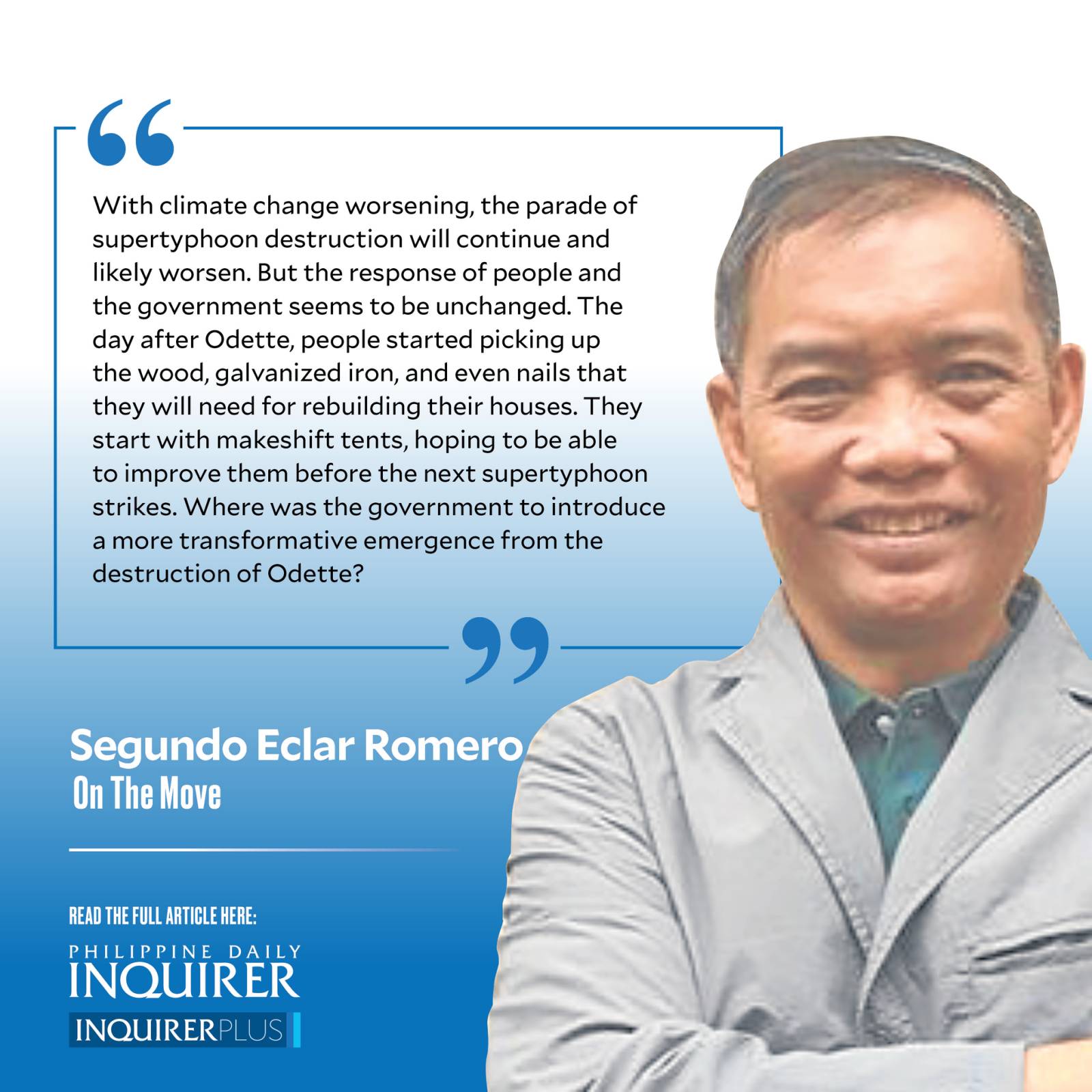Transformative hope

There are about 20 typhoons that cross the Philippines every year. A typhoon that causes 300 or more deaths or P1 billion in destruction is scratched from the list of local typhoon names (“retired”). Into this “Hall of Shame” now belong “Yolanda,” “Pablo,” “Sendong,” “Ondoy,” “Frank,” “Milenyo,” or “Reming.” Last month’s terror, Supertyphoon “Odette,” with a death toll of over 407 and damage at P24.5 billion, qualifies to join them.
With climate change worsening, the parade of destructive supertyphoons will continue and likely worsen. But the response of people and the government seems to be unchanged. The day after Odette, people started picking up the wood, galvanized iron, and even nails that they will need for rebuilding their houses. They start with makeshift tents, hoping to be able to improve them before the next supertyphoon strikes. Where was the government to introduce a more transformative emergence from the destruction of Odette?
Article continues after this advertisementSuch transformative action does not seem to be evident in the government’s actions. The newly organized shelter superagency, the Department of Human Settlements and Urban Development (DHSUD) seems to reinforce the traditional palliative approach. It reports that it has distributed P5,000 each to about 100,000 affected families in Regions 4B, 6, 7, 8, 10, and 13, or a whopping total of 50 million pesos. It has also given out 12,000 “shelter grade” tarpaulins and 1,000 shelter repair kits consisting of GI sheets, lumber, plywood, tarpaulin, nails, and carpentry tools.
This sounds officiously diligent, until one juxtaposes these modest input-oriented reports against the recovery and rehabilitation outcomes required. The NDRRMC reports a total of 1,360,447 houses partially (991,971) or totally (368,476) damaged. People across eight regions continue to desperately call for food, water, transportation, gasoline, electricity, health services, shelter, livelihood, banking services. Beyond meeting these, the government must offer transformative hope.
The response signals coming from the government are not comforting. In the online shelter cluster conference called by DHSUD Secretary Eduardo Del Rosario early this month to synchronize the government’s shelter assistance to the victims, he declared: “Now is the time for us to make an assessment on where we are now and where we intend to go. We must know the situation on the ground and address budgetary needs in order to carry out our assistance programs. We must establish and determine doable timelines to achieve our objectives in compliance with the instructions of the President.” This post-disaster keynote seems woefully lagged. Also, the news report ended with a cryptic statement: “Members of the National Shelter Cluster, particularly Secretary Lapeña, Usec Jalad, and GM Escalada, expressed full support to the Shelter Cluster headed by Secretary Del Rosario.”
Article continues after this advertisementMeantime, there are signals of self-help and mutual help by the people. To shelter from Odette, the people of Marabut in Samar skipped the usual evacuation centers and knew where to go—Tinabanan Cave. This is where 1,176 of them sheltered during Supertyphoon Yolanda in 2013. The 8-foot high entrance opens into two caverns that are as high as a three-story building. There are five other caves scattered under the hills. Since Yolanda, the people of Marabut have organized and conducted survival training in Tinabanan Cave. With the help of NGOs, they have built emergency solar lighting, rain catchment water tanks, a toilet, and kitchen.
Some families in Barangay Tigbauan in Leyte sheltered in man-made tunnels dug on the hillside, which they reinforced with wooden beams. The families dug the tunnel after Supertyphoon Yolanda hit in 2013. They have used the tunnel to shelter from repeated storms since then.
These self-help efforts remind me of the civic empowerment that community pantries represented when they mushroomed last year. Maybe people are realizing they can build back better by relying on self-help and mutual help, in the face of the government’s daft response. But it is clear that self-help efforts also signal a growing disenchantment with the government’s ability and willingness to help the people avoid and recover from recurring and debilitating disasters.
—————-
doyromero@gmail.com
















